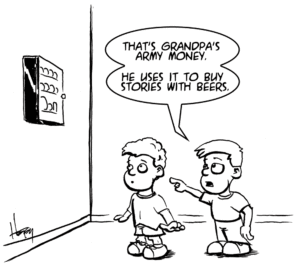A group of us were talking, and a friend said “I heard a new joke!” Then he turned to me and said “Howard’s probably heard it already, but here goes…”
Q: What’s the difference between boogers and broccoli?
A: Kids won’t eat broccoli.
We all laughed (we includes me) and then in mock astonishment my friend said “you hadn’t heard that one?”
“Not that one” I replied, “but I’ve heard lots of jokes like it. By the time you’d finished the question I had three punchlines. You used the straight one. It’s a good one though. I laughed.”
At this point everybody was eyebrows-up. Was I really claiming to have three punchlines to a joke I’d just heard? Well, yes. The “what’s the difference between X and Y?” joke is a formula with lots of formulaic punchlines. Of course, it helped that broccoli is a food. In that context I immediately knew the stock punchline had to do with eating.
I went on: “I would have gone the self-deprecatory route, and said ‘I still won’t eat broccoli.”
They laughed, and there was some groaning. Formulaically, that punchline encapsulates the ‘kids eat boogers but not vegetables’ thought, and additionally identifies me as a kid in the worst possible way.
But I wasn’t done: “And then there’s one of the earliest change-ups on the joke: ‘that explains the broccoli salad you made.'”
More groaning, but still lots of laughter. Also, I could tell that this group of people was now nervous about telling me jokes. Hey, it’s okay to tell me a joke. Just don’t call attention to the fact that I may have heard it, because that’s a setup for more jokes and a soapbox.
I later shared this experience with my 12-year-old son, and we realized that there was a self-deprecatory version of that third punchline, giving us a fourth:
A: Oh, good. You’ll like this broccoli salad just fine.
For me, THAT one is the home run. Self-deprecatory AND I’m making YOU eat the boogers. Win/win!
The operating principle here, for me anyway, is that lots of setups can deliver more than one punchline, and often a good punchline can be made into a great one, or fine-tuned for the audience, with a little exploration. Using the same basic setup, I tried this on one of my old favorites, which goes like this:
Q: What’s the difference between a clarinet and an onion?
A: Nobody cries when you chop up a clarinet.
I quickly arrived at one where the joke is on the listener (the classic change-up on the formula):
A: This explains why you’ve had such trouble learning to play the clarinet.
Now that it was personal, it was time to return to the onion:
A: I didn’t cry when I chopped up your clarinet.
I’ve talked before about how the first punchline that comes to mind is low-hanging fruit. If you want to learn how to reach further up into the tree, take some old “Dad” jokes like these and see what other punchlines their setups can lead to.
And don’t be afraid to play with the setup, too. I love this gem:
Q: What’s the difference between an accordion and a trampoline?
A: Take off your shoes before jumping on the trampoline.
As I mused upon other punchlines, my son said “is an accordion sort of like a bagpipe?” Ah, my young genius…
Q: What’s the difference between an accordion and a bagpipe?
A: Which side of the road you’re on when you hit the player with your car.
(*Note: For the record, I enjoy well-played accordions, bagpipes, and clarinets, and not only can I tell the difference between broccoli and boogers, I can tell the difference between broccoli and cauliflower, and I’ll eat both of them.)
 Everything has been handed off to Sandra. An update will go out to Kickstarter supporters first, and then the PDF will go live, probably by Tuesday of next week.
Everything has been handed off to Sandra. An update will go out to Kickstarter supporters first, and then the PDF will go live, probably by Tuesday of next week.